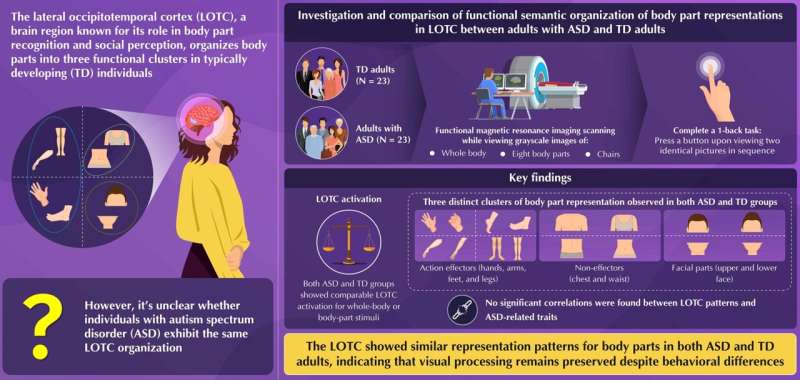Autism range clutter (ASD), a neurodevelopmental condition, is frequently related with troubles in social communication and dreary behavior. Past inquire about uncovers that individuals with ASD regularly discover it challenging to translate eagerly from body dialect and have trouble recognizing faces and feelings, which may contribute to their social communication problems.
Scientists conjecture that these challenges might emerge from contrasts in how the brain sees faces and body parts, i.e., how people with ASD speak to the human body. Be that as it may, until presently, no think about had clearly mapped how body parts are spoken to in the brains of grown-ups with extreme introvertedness or whether that organization varies from ordinary or ordinarily creating (TD) adults.
In a nitty gritty neuroimaging consider including grown-ups in Japan, analysts tended to this information crevice by analyzing how ASD speaks to body parts in the brain. This think about was distributed in the diary Imaging Neuroscience. A group of analysts utilized utilitarian attractive reverberation imaging (fMRI) to compare brain movement designs in grown-ups with ASD and TD grown-ups as they seen pictures of body parts.
“Our objective was to test whether the horizontal occipitotemporal cortex (LOTC)—a brain locale known to speak to visual data approximately diverse body parts in a clustered way—functions in an unexpected way in grown-ups with extreme introvertedness,” says lead analyst Partner Teacher Yuto Kurihara from the Workforce of Human Sciences, Waseda College, Japan.
The inquire about group included Teacher Hirotaka Kosaka from Fukui College, Teacher Rieko Oso, and Visitor Junior Analyst Yuko Okamoto from Waseda University.
The analysts selected 23 grown-ups with ASD and 23 TD grown-ups. Each member experienced fMRI checking whereas seeing grayscale pictures of eight body parts (e.g., hands, legs, confront), the entirety body, and chairs as a control question. Members completed a 1-back errand, squeezing a button at whatever point an indistinguishable picture showed up twice in a push, to guarantee consideration amid the scan.
The fMRI information appeared that both bunches actuated the LOTC when seeing whole-body pictures. Vitally, there were no critical contrasts in the measure or quality of this enactment between the ASD and TD bunches, demonstrating comparative fundamental visual responsiveness.
To see more profound, the analysts utilized an progressed examination strategy to get it how the brain organizes data approximately diverse body parts. They found that in both bunches, the LOTC gathered body parts into three categories: activity effectors (hands, feet, arms, and legs), non-effectors (chest and midsection), and facial parts (upper and lower face).
“These comes about recommend that grown-ups with extreme introvertedness see visual body data in much the same way as neurotypical grown-ups,” says Kurihara. “This challenges long-standing suspicions that contrasts in body-related recognition contribute to social troubles in ASD.”
To make beyond any doubt the comes about were strong, the group moreover tried whether brain movement designs seem precisely recognize between diverse body parts. Once more, both bunches performed essentially. The analysts too analyzed whether brain designs were connected to person differences—such as extreme introvertedness side effect seriousness or tangible traits—but found no solid connections.
Interestingly, prior ponders in extremely introverted children appeared distinctive brain reactions in the LOTC. But Kurihara’s group considers this may alter with age. “Children with extreme introvertedness may see body-related data in an unexpected way, but those contrasts appear to blur as they develop up,” Kurihara explains.
Overall, the ponder appears that whereas individuals with extreme introvertedness may battle to examined feelings or eagerly from signals or expressions, the challenge may lie in deciphering these signals—not in seeing them in an unexpected way. This knowledge may offer assistance shape more viable mediations, such as instructing social understanding or impersonation, particularly for adults.
“Our brains keep learning,” Kurihara says. “This ponder gives us hope—and a reason to keep making strides how we bolster individuals with extreme introvertedness at each arrange of life.”




